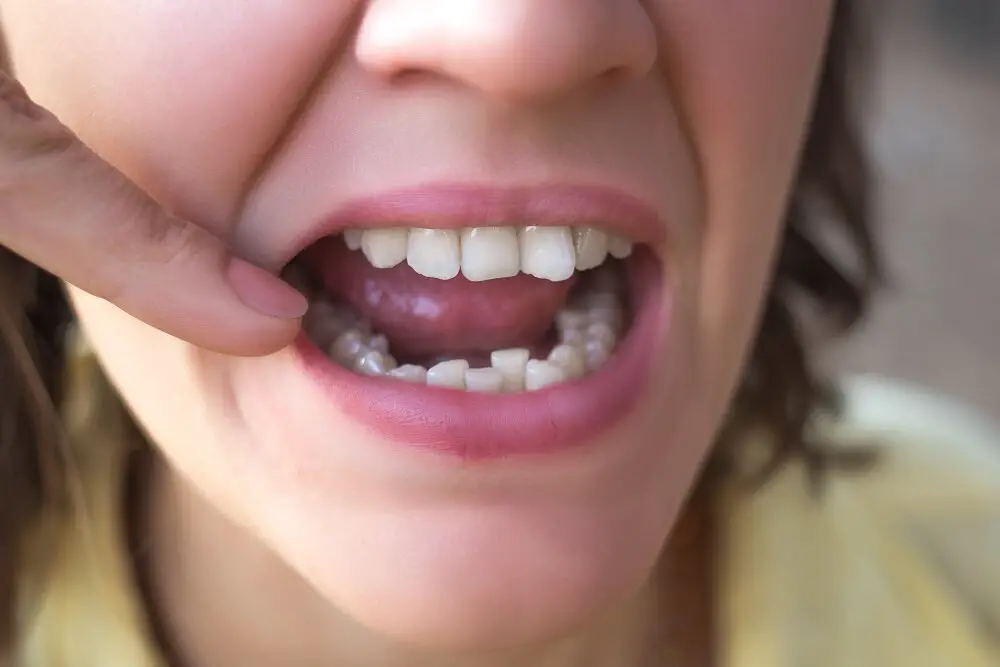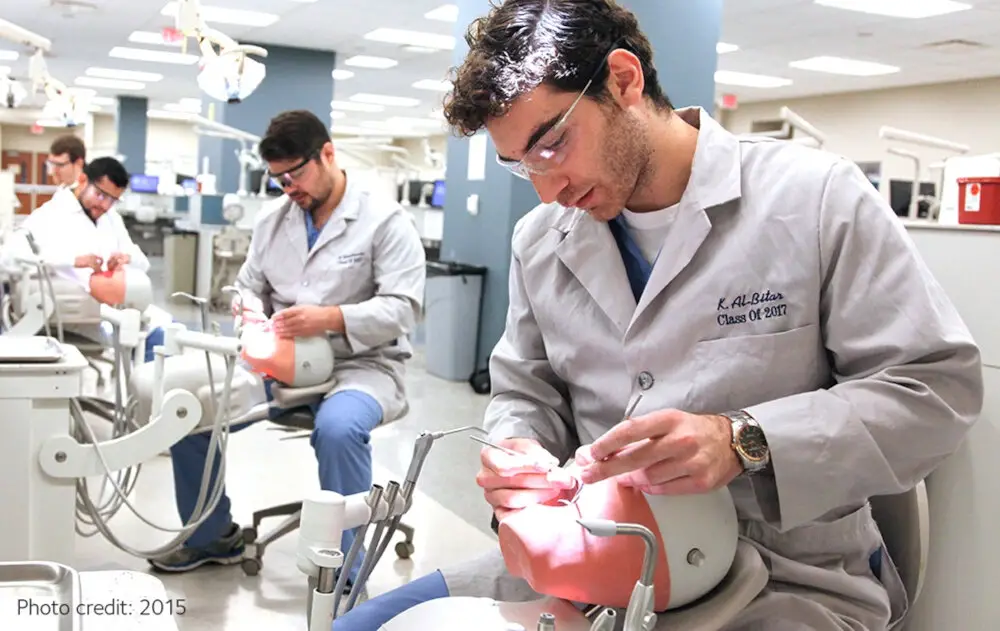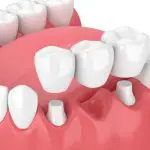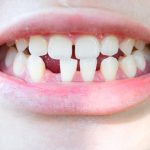Why Food Gets Stuck in Your Teeth: Causes and Solutions

Food getting stuck in your teeth is not only a nuisance, but it can also be a source of discomfort and embarrassment. This common occurrence happens to almost everyone, and it can be caused by a variety of factors such as the type of food you eat, the structure of your teeth, or poor oral hygiene. Fortunately, there are several solutions to this problem that can help you avoid discomfort and maintain good oral health. One of the most common causes of food getting stuck in your teeth is the type of food you eat. Certain foods such as popcorn, seeds, nuts, and stringy vegetables like celery can easily get lodged between your teeth. Additionally, foods that are high in sugar or carbohydrates can stick to your teeth and create a breeding ground for bacteria, leading to cavities and other dental problems. Another factor that can contribute to food getting stuck in your teeth is the structure of your teeth. Teeth that are tightly spaced, crooked, or have large gaps between them are more likely to trap food particles. Lastly, poor oral hygiene can also be a major culprit. Not brushing and flossing regularly can lead to the buildup of plaque and food debris, which can cause food to get stuck and even lead to gum disease.
Anatomy of Teeth and Gums

The anatomy of teeth and gums is an important consideration when it comes to understanding why food gets stuck in your teeth. Teeth are composed of several layers, including the enamel, dentin, and pulp. The enamel is the outermost layer of the tooth, which protects it from damage and decay. The dentin is the layer beneath the enamel and provides the tooth with its structure and shape. The pulp is the innermost layer of the tooth, which contains nerves and blood vessels. Gums, on the other hand, are the soft tissue that surrounds and supports the teeth. They are made up of a dense network of blood vessels and nerves that help to keep the teeth in place. One of the reasons why food gets stuck in your teeth is due to the shape and size of your teeth. Some people have teeth that are closer together, which makes it easier for food to become trapped between them. Additionally, the shape of your teeth can also make it more difficult for you to remove food particles. For example, the molars in the back of your mouth have more grooves and crevices than other teeth, making them more likely to trap food. Another reason why food gets stuck in your teeth is due to the health of your gums. If your gums are inflamed or receding, they may not be able to hold your teeth as tightly, which can allow food particles to become trapped between your teeth and gums.
Teeth and gum structure is critical to maintaining good oral health. The teeth are made up of four main parts: enamel, dentin, pulp, and cementum. Enamel is the hard, outer layer that protects the tooth from damage. Dentin is the softer layer beneath the enamel, and pulp is the innermost layer that contains nerves and blood vessels. Finally, cementum is a layer that covers the root of the tooth. The gums surround and support the teeth, and they are made up of two layers: the outer layer of gingiva and the inner layer of periodontal ligament. Together, these structures work to keep our teeth healthy and functioning properly. However, when food gets stuck in our teeth, it can cause discomfort and even lead to more serious dental issues.
Teeth and gums work together to break down food and aid in digestion. Teeth are responsible for biting, tearing, and grinding food into smaller pieces, while the gums protect teeth and keep them securely in place. The tongue then moves the food around the mouth and pushes it towards the back of the throat for swallowing. The shape and alignment of teeth play a significant role in this process. The gums support and nourish teeth with blood vessels, and they act as a barrier to prevent harmful bacteria from entering the body. Proper dental hygiene, including brushing and flossing, is essential to maintain the health of both teeth and gums, preventing food particles from getting stuck and leading to further dental problems.
Food particles can get stuck in teeth and gums due to their sticky or fibrous nature. Certain types of foods, such as meats, fruits, and vegetables, have fibers that can easily get lodged between teeth. Additionally, foods that are high in sugar or carbohydrates can cause bacteria to produce acid, which can weaken the enamel of the teeth and lead to decay. This decay can create small crevices and spaces in the teeth, which can trap food particles. When food particles remain stuck in the teeth and gums, they can lead to bad breath, gum disease, and tooth decay. Proper dental hygiene, such as brushing and flossing regularly, can help prevent food particles from becoming trapped in the teeth and gums.
Causes of Food Getting Stuck in Teeth

Food getting stuck in teeth is a common problem that many people face on a daily basis. It can be an uncomfortable and embarrassing situation that can lead to bad breath, gum disease, and tooth decay. There are several reasons why food gets stuck in teeth, and understanding these causes can help prevent this problem from occurring. One of the main causes of food getting stuck in teeth is the shape and alignment of teeth. If there are gaps or irregularities in the teeth, food particles can easily get trapped and become stuck. Additionally, crowded teeth can also make it difficult to clean between teeth, leading to food getting trapped. Another cause of food getting stuck in teeth is the type of food being consumed. Sticky and chewy foods such as candy, caramel, and dried fruit are more likely to get stuck in teeth than other types of foods. Foods that break apart into small pieces such as popcorn and seeds can also get trapped in between teeth. Finally, poor oral hygiene can also contribute to food getting stuck in teeth. If teeth are not brushed and flossed regularly, food particles can build up and become stuck in between teeth.
Certain types of food have a notorious reputation for getting stuck in your teeth, causing discomfort and sometimes even pain. Foods that are sticky or chewy, such as caramel, taffy, and dried fruits, have a tendency to cling to your teeth and gums, making them difficult to remove with just a quick rinse of water. Foods that are hard or crunchy, like popcorn kernels, nuts, and seeds, can also get lodged between your teeth, sometimes requiring floss or a toothpick to dislodge. Even some healthy foods, such as spinach or kale, can leave small pieces stuck in your teeth due to their fibrous texture. Being mindful of these types of foods and taking extra care to clean your teeth after eating them can help prevent uncomfortable and potentially harmful situations.
Eating habits play a significant role in causing food to get stuck in teeth. Foods that are sticky, chewy, or contain small particles such as popcorn or sesame seeds can easily get lodged in the spaces between teeth. Chewing with your front teeth instead of your molars can also increase the likelihood of food becoming stuck. Additionally, not drinking enough water while eating can prevent the food from being washed away and increase the chances of it getting stuck. Poor oral hygiene, such as not brushing or flossing regularly, can also contribute to food becoming trapped in teeth. By being mindful of the foods we eat and practicing good oral hygiene habits, we can prevent the discomfort and potential dental issues that come with food getting stuck in teeth.
There are several dental conditions that can cause food to get stuck in teeth, including cavities, gum disease, and misaligned teeth. Cavities are the most common culprit, as they can create small crevices in the teeth that trap food particles. Gum disease can also cause food to get stuck, as it can cause the gums to recede and expose the roots of the teeth, which are more porous and prone to trapping food. Misaligned teeth can also make it difficult to clean between teeth, leading to food getting stuck in the gaps. In order to prevent food from getting stuck in teeth, it is important to maintain good oral hygiene habits, such as brushing and flossing regularly, and to visit a dentist for regular check-ups and cleanings.
Problems Caused by Food Stuck in Teeth

Food stuck in teeth is a common problem that many people face. While it might seem like a minor inconvenience, food particles trapped between teeth can lead to a host of problems. The first and most obvious issue is discomfort. Food stuck in between teeth can cause irritation, pain, and swelling, which can make it difficult to eat, speak or even concentrate on work. Additionally, if left unattended, it can become a breeding ground for bacteria, leading to tooth decay and gum disease. The accumulation of food particles between teeth can also lead to bad breath. This is because the bacteria that thrive on food particles can release unpleasant odors. The longer the food remains stuck in the teeth, the more potent the smell can become. This can be quite embarrassing, especially in social situations where bad breath can be a turn-off. In some cases, bad breath can also be a sign of a more serious dental problem, such as an infection or gum disease, so it is important to address the issue promptly. Regular brushing and flossing are essential for maintaining good oral hygiene and preventing food from getting stuck in between teeth.
Bad breath, also known as halitosis, can be caused by a variety of factors, including poor dental hygiene, gum disease, and certain medical conditions. When food gets stuck in your teeth, it can also contribute to bad breath by providing a breeding ground for bacteria to thrive. These bacteria can produce foul-smelling gases that are released into the air when you talk or breathe, causing embarrassment and discomfort. To prevent bad breath and keep your teeth and gums healthy, it’s important to brush and floss regularly, drink plenty of water, and avoid foods that are high in sugar and carbohydrates. If you’re experiencing persistent bad breath, it’s a good idea to see your dentist or doctor to rule out any underlying medical conditions.
Tooth decay, also known as dental caries, is a common dental problem that occurs when the bacteria in the mouth produce acid that erodes the tooth enamel. This can be caused by poor oral hygiene, a diet high in sugar and carbohydrates, and certain medical conditions that reduce saliva production. Tooth decay can lead to cavities, sensitivity, and even tooth loss if left untreated. Preventive measures such as regular brushing and flossing, reducing sugar intake, and visiting the dentist can help prevent tooth decay. Treatment options include fillings, root canals, and extractions depending on the severity of the decay.
Gum disease, also known as periodontal disease, is a serious oral health issue that can cause a wide range of problems. It is caused by the buildup of bacteria in the mouth, which can lead to inflammation, bleeding, and damage to the gums and teeth. Some of the common symptoms of gum disease include bad breath, swollen or bleeding gums, and loose or shifting teeth. If left untreated, gum disease can lead to more serious problems, such as tooth loss and bone damage. To prevent gum disease, it is important to practice good oral hygiene, including regular brushing and flossing, and to visit a dentist regularly for checkups and cleanings.
Infection is one of the consequences that can arise from food being stuck in your teeth. Bacteria thrive in the warm, moist environment of the mouth, and when food particles are left to rot between teeth, they provide an ideal breeding ground. This can lead to a bacterial infection known as gingivitis, which causes irritation and inflammation of the gums. If left untreated, gingivitis can progress to periodontitis, a more serious form of gum disease that can damage the bone and tissues supporting the teeth. In severe cases, tooth loss may occur. To prevent infection, it is important to maintain good oral hygiene habits, including regular brushing and flossing, and to seek professional dental care as needed.
Solutions for Food Stuck in Teeth

Food getting stuck in your teeth can be an annoying and sometimes painful experience. However, there are several solutions for this common problem. One of the most effective ways to dislodge food stuck in your teeth is to floss. Flossing is an essential part of good oral hygiene and helps to remove plaque, food particles, and bacteria from between teeth. It’s recommended to floss at least once a day, preferably after meals, to prevent food from getting stuck in your teeth in the first place. If you don’t have floss on hand, you can also try using a toothpick or interdental brush to remove the food. Another way to remove food stuck in your teeth is to rinse your mouth with water. Swishing water around in your mouth can help to dislodge any food particles that are stuck between teeth. If you have access to mouthwash, this can also be an effective way to remove food particles and freshen your breath at the same time. Additionally, chewing sugarless gum after meals can help to stimulate saliva production, which can help to rinse away any food particles that are stuck in your teeth. However, it’s important to note that chewing gum should not be used as a substitute for proper oral hygiene practices such as brushing and flossing.
Proper brushing and flossing techniques are essential for maintaining good dental hygiene and preventing food from getting stuck in your teeth. When brushing, use a soft-bristled brush and fluoride toothpaste and brush your teeth in circular motions for at least two minutes, making sure to reach all surfaces, including the back teeth. Don’t forget to brush your tongue to remove bacteria that can cause bad breath. Flossing should be done at least once a day, using a gentle back-and-forth motion to remove food particles and plaque from between teeth and under the gum line. If you have trouble flossing, consider using interdental brushes or water flossers. By following these techniques, you can keep your teeth and gums healthy and free from food debris.
Interdental cleaners are an essential tool for maintaining oral health and preventing food from getting stuck in between teeth. They are designed to reach areas that toothbrushes cannot clean, such as the gaps between teeth and the gum line. Interdental cleaners come in various forms, including dental floss, interdental brushes, and water flossers. Each type of interdental cleaner has its unique advantages, and it is essential to choose the right one for your needs. Regular use of interdental cleaners can help remove food particles and plaque, reducing the risk of developing gum disease and tooth decay. Therefore, incorporating interdental cleaning into your daily oral care routine is crucial for maintaining optimal dental health.
Regular dental checkups and cleanings are crucial to maintaining good oral health and preventing food from getting stuck in your teeth. During a routine checkup, your dentist can identify any potential problems early on and provide necessary treatment. A dental cleaning helps remove any buildup of plaque and tartar that can cause cavities and gum disease. This is especially important if you have a habit of snacking frequently throughout the day or consuming sugary or sticky foods. Neglecting regular dental checkups and cleanings can lead to more serious dental issues down the road, so it’s essential to prioritize this aspect of your health.
Dietary changes can be an effective solution to prevent food from getting stuck in your teeth. Foods that are high in fiber, such as fruits, vegetables, and whole grains, can help keep your teeth and gums healthy by stimulating saliva production and promoting regular chewing. Additionally, avoiding sticky or sugary foods can reduce the risk of food particles getting stuck in your teeth and causing tooth decay. Finally, incorporating foods that contain calcium and phosphorus, such as cheese and nuts, can help strengthen your teeth and reduce the risk of cavities. Making small adjustments to your diet can go a long way in improving your oral health and preventing the discomfort and embarrassment of food getting stuck in your teeth.
When we eat, small pieces of food often get stuck in our teeth, leading to unpleasant sensations and possible health problems. The causes of food impaction vary, from eating sticky or fibrous foods to having gaps between teeth or misaligned teeth. Poor oral hygiene can also contribute to this issue, as bacteria and plaque buildup can cause teeth to shift or become loose. If left untreated, food stuck in teeth can lead to bad breath, cavities, and gum disease. Fortunately, there are solutions to this problem, including flossing, brushing with a soft-bristled toothbrush, rinsing with mouthwash, and visiting the dentist regularly for cleanings and checkups. By taking these steps, you can keep your teeth healthy and free of food impaction.
There are a variety of solutions to prevent food from getting stuck in your teeth, ranging from simple habits to more specialized tools. The most basic solution is to thoroughly brush and floss your teeth after meals, which can dislodge any food particles that may be stuck. Additionally, chewing sugar-free gum can help stimulate saliva production, which can aid in washing away food debris. For those who frequently experience food getting stuck, using a water flosser or interdental brush can provide more targeted cleaning and remove stubborn particles. It’s also important to be mindful of the types of foods you eat, as sticky or fibrous foods are more likely to get stuck in your teeth. By implementing these strategies, you can prevent the discomfort and potential dental issues that come with food particles getting stuck in your teeth.
Maintaining good oral health is crucial for overall wellbeing. Along with brushing and flossing twice a day, it is essential to avoid sugary and sticky foods that can get stuck in your teeth. Incorporating crunchy fruits and vegetables like apples and carrots can help stimulate saliva production and clean teeth naturally. Regular check-ups with your dentist can also detect and prevent any potential dental problems. It is important to address any food impaction issues as soon as possible to prevent further complications. By following these recommendations, you can ensure good oral hygiene and keep your teeth and gums healthy.
Conclusion

In conclusion, understanding why food gets stuck in your teeth is crucial for maintaining good oral health. From eating certain foods to having gaps in your teeth, there are several causes that can lead to food getting stuck. However, implementing simple solutions such as proper brushing and flossing techniques, avoiding sticky and hard-to-chew foods, and regularly visiting your dentist can help prevent food from getting stuck and reduce the risk of dental issues. It’s essential to prioritize oral hygiene and take proactive steps to keep your teeth healthy and free from food particles. By doing so, you can enjoy your favorite foods without worrying about the discomfort and potential dental problems that come with food getting stuck in your teeth.







